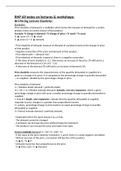RHP All notes on lectures & workshops:
RH Pricing Lecture Elasticity:
Elasticities:
Price-elasticity of demand is a multiplier which shows the measure of demand for a certain
product reacts on a price chance of that product.
Formula: % change in demand / % change of price = % result / % cause
% ▲ cause x E = % ▲ result
% ▲ price x E = % ▲ demand
- Price-elasticity of demand: measure of demand of a product reacts on the change of price
of that product.
- Negative connection of the price and demand of that product..
- Price depreciates -> demand rises
- Price-elasticity of demand: in general, there is a negative connection.
- If the value of price elasticity is -2,1, that means: an increase of the price 1% will lead to a
decrease of the demand of 2,1% (1% * 2,1).
- A decrease of the demand 3% will lead to an increase of demand 6,3%.
Price elasticity measures the responsiveness of the quantity demanded or supplied of a
good to a change in its price. It is computed as the percentage change in quantity demanded
—or supplied—divided by the percentage change in price.
Price elasticity of demand:
∞ = Relative elastic demand = perfectly elastic,
-1 > < 0 > < 1 = Relative inelastic demand= inelastic, not very responsive, where a given
percentage change in price will cause a smaller percentage change in quantity demanded or
supplied.
< -1 or 1>= elastic, very responsive, indicate that the quantity demanded or supplied
responds to price changes in a greater than proportional manner.
1= unitary, percentage change in price leads to an equal percentage change in quantity
demanded or supplied.
0 = Perfect inelastic demand = perfectly inelastic,
- Duplicated with 0 (Ev) gives always 0 as a result.
- The demand cannot be changed.
- A producer can increase the price without losing his customers.
- The producer can increase the price and make more sales.
Relative inelastic demand (-1 < Ed < 0 > and < 1):
- If the value of the price elasticity is between -1 and 0, there is e weak negative correlation.
- With an increase of the price, a consumer will buy less of the product.
- % ▲ Q < % ▲ P.
- Demand reacts less than proportional on the price.
- % ▲ Price x Ed = % ▲ Demand
, - If in the above formula, the percentual change of the price is multiplied with an elasticity
(Ed) between -1 and 0 the outcome will give a smaller figure. (the percentual change of the
demand).
- For example: +5% x -0,5 -> -1,67% -> % ▲ Qd < % ▲ P
- (NB: absolute value: so, if the figures are positive)
- 8% x -5/8 -> +5% -> the % ▲ Q < % ▲ P
- (NB: absolute value: so, if all figures are positive).
- A producer can increase his price in this situation, loose some customers, but on balance
it creates more turnover.
- A producer can increase the price and calculate more turnover (price x sales = revenue).
Relative elastic demand (Ed < -1 or 1>)
- If the value of price elasticity is smaller than -1, there is a strong negative relation by an
increase of prices and the consumer buys much less of the product: % ▲ Q > % ▲ P.
- Demand reacts more than proportional on the price: % ▲ P x Ed -> % ▲ Q.
- If in earlier shown formula, the percentual change of the price is multiplied with an
elasticity (Epv) smaller than -1, the outcome will give a bigger figure. (the percentual change
of the question).
- For example: -5% x -20 ->100% -> the % ▲ Q > % ▲ P.
- (NB: absolute value: if all figures are positive.)
- +2,5% x -3 = -7,5% -> de % ▲ Q > % ▲ P.
- (NB: absolute value: all figures are positive).
- A producer can increase his price, but lose a lot of customers, so his sales will decrease in
total.
- A producer increases his price, but it gives a decrease in sales. (price * sales = revenue)
Cross demand:
- At cross demand there is a connection between the demand of a product or service and its
reaction on the change of price of another product or service.
- % ▲ cause x E = % ▲ result.
- % ▲ price product A x Ec = % ▲ demand product B.
- Example: At which percentage will the demand for condensed milk decrease if the price of
coffee increases?
- Or with how much % will the demand of public transport increase if the price of fuel
increases?
- At cross demand elasticity the relation can be positive or negative.
- Coffee and condensed milk.
- With fuel and public transport, we see a positive relation. (P fuel ^ -> Q public transport ^).
- This positive or negative relation depends on the relation between products and/or
services.
- Coffee and condensed milk are complementary goods.
- Fuel and public transport substitute each other. We call that substitution goods, they have
a positive relation.





